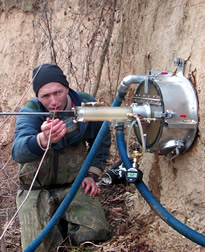This page has been archived and is being provided for reference purposes only. The page is no longer being updated, and therefore, links on the page may be invalid.
|
|
Stronger Embankments Start in the Lab
By Ann PerryMarch 27, 2008
The safety of earthen embankments, including levees and dams, depends in large part on how resistant they are to erosion. That resistance can hinge on the soil materials used in their construction.
Hydraulic engineers Gregory J. Hanson and Sherry L. Hunt work at the Agricultural Research Service (ARS) Hydraulic Engineering Research Unit in Stillwater, Okla. They have refined methods for estimating the erodibility of large embankment structures with a lab-scale version of the Jet Erosion Test (JET).
Hanson developed JET to evaluate the condition of streams and dam embankments. In the field, JET applies stresses to soil beds with a water jet that can be pumped at various flow rates.
The team studied the roles of compaction effort—the mechanical force needed to increase soil density—and water content in soil erosion. They measured compaction effort using standard engineering tests, which involve dropping a hammer onto soil samples from a specific distance for a specified number of times. As part of their evaluation of compaction effort, they also varied the soil water content, which affects soil plasticity, in their samples.
The engineers observed that the erodibility of their lab samples varied significantly between the two soil types they tested, which were a silty sand and a silty clay. Both soil types also exhibited a large range of erosion, depending on compaction effort and water content.
For instance, lab soil samples that were compacted while containing optimum levels of water showed a significantly stronger resistance to erosion. Higher compaction efforts also increased erosion resistance, and soil texture and plasticity influenced erosion resistance as much, or sometimes even more, than compaction factors. The team compared these results with large-scale field controls and found that their lab-scale JET tests accurately assessed soil erodibility in samples as small as 10 centimeters in diameter.
Overall, these results indicate that soil type and compaction factors can be used to make soil at least 1,000 times more resistant to erosion. These findings will help engineers factor in soil type and other variables to predict embankment failure rates when designing flood control structures.
ARS is the U.S. Department of Agriculture's chief scientific research agency.

